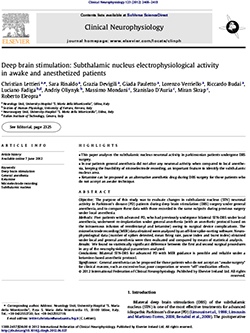
The purpose of this study was to evaluate changes in subthalamic nucleus (STN) neuronal activity in Parkinson's disease (PD) patients during deep brain stimulation (DBS) surgery under general anesthesia, and to compare these data with those recorded in the same subjects during previous surgery under local anesthesia.
Five patients with advanced PD, who had previously undergone bilateral STN-DBS under local anesthesia, underwent re-implantation under general anesthesia (with an anesthetic protocol based on the intravenous infusion of remifentanyl and ketamine) owing to surgical device complications. The microelectrode recording (MER) data obtained were analyzed by an off-line spike-sorting software. Neurophysiological data (number of spikes detected, mean firing rate, pause index and burst index) obtained under local and general anesthesia were then evaluated and compared by means of statistical analysis.
We found no statistically significant difference between the first and second surgical procedures in any of the neurophysiological parameters analyzed.
Bilateral STN-DBS for advanced PD with MER guidance is possible and reliable under a ketamine-based anesthetic protocol.
General anesthesia can be proposed for those patients who do not accept an "awake surgery" for clinical reasons, such as excessive fear, poor cooperation or severe "off"-medication effects.
